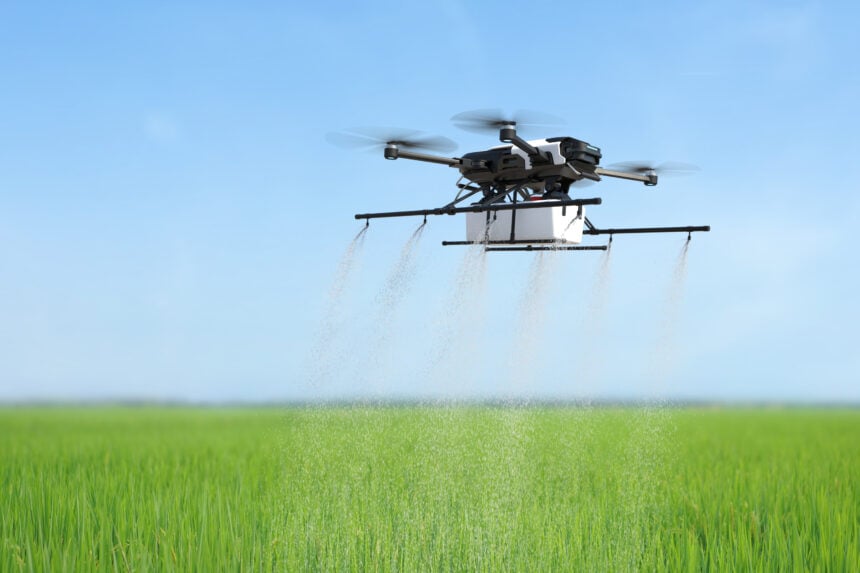Robotic pollinators are buzzing into the spotlight — but are they real solutions or just shiny sci-fi? Let’s unpack what these machines can (and can’t) do, and how they might mesh with the living ecosystem that already powers our food.
Robotic Pollinators, Explained (No Hype Required)
At the simplest level, robotic pollinators are devices — drones, rovers, or micro-bots — designed to carry pollen from flower to flower. They’re not here to dethrone bees; they’re attempting to supplement natural systems where those natural systems are under stress. The motivation isn’t mysterious: growers are managing tighter labor windows, extreme weather, and the very real backdrop of pollinator decline. If you farm almonds, apples, berries, squash, or seed crops, you already live and die by bloom timing. A robot that can work the night shift or hustle during a short weather window sounds pretty great.
Why Now? The Bee Crunch, By the Numbers
Bees face a mash-up of challenges — habitat loss, disease and parasites, climate swings, and chemical exposure — and farmers feel the downstream impact during bloom. The science community has documented multiple strands of evidence of pollinator decline, especially in regions where monocultures and fragmented habitat collide. When bloom windows compress into a few cool mornings or a single warm afternoon, having additional “hands” (propellers?) on deck becomes less of a novelty and more of an insurance policy.
“If robots can handle nighttime bloom windows, that’s huge for orchards.” — a TikTok user
How Robotic Pollination Actually Works
Seeing the Flower — Sensors, Vision, and Edge AI
To find and service blossoms, a bot needs sharp eyes. Today’s prototypes mix RGB cameras, depth sensors, GPS/RTK, and occasionally LiDAR with on-board inference to classify flowers, estimate pollen stage, and plan approach angles in real time. That’s where edge AI enables split-second decisions: you can’t stream every pixel to the cloud from a windy orchard and wait for instructions — the machine needs to recognize a blossom and act within milliseconds.
Navigation typically pairs visual odometry with field maps or vine-row detection. Some rigs run semi-autonomously in guarded routes; others are tele-operated with autonomy assisting at the moment of contact.
Touching the Flower — Brushes, Gels, and Micro-Drones
Contact is delicate. Early lab videos popularized gel-coated robotic bees, where a sticky surface picks up and deposits pollen. Other systems use soft micro-brushes, puffs of air, or gentle suction to avoid bruising petals. A bio-inspired drone demonstration showed how miniature flight plus compliant end-effectors can place pollen precisely — and more importantly, repeatably — across a row.
Engineers obsess over three details: tip force (too much and you damage flowers), dwell time (too short and you don’t transfer pollen), and approach stability (gusts and branch sway are real). Every point on that triangle affects fruit set later.
Myth vs Reality — What Today’s Prototypes Can (and Can’t) Do
Let’s burst a few bubbles while giving credit where it’s due.
Range, Battery, and Control Limits
Tiny flyers are energy-constrained. Flight time is often measured in minutes, not hours. That’s why some research focused on tethers and perches before making progress to free flight and autonomous interaction. Harvard’s microrobotics lab, for instance, has documented RoboBee landing advances that sound niche, but each incremental improvement (landing, takeoff, orientation control) knocks down a real barrier to practical field behavior. Translation: amazing progress, but not ready to blanket 5,000 acres of almonds from the air — yet.
Costs and Scale — Can Small Bots Touch Big Acreage?
A sobering reality: a single acre of apples can host tens of millions of blossoms. Multiply that by a region, and you’re quickly in “fleet management” territory. For many row crops, the math won’t work unless robots run as services — scheduled teams that hit orchards at peak bloom with docking stations, swappable batteries, and highly optimized routes. That’s not a failure; it’s the same arc tractors followed (rental fleets, custom operators) and what we see with specialty-spray drones today.
“Cool tech, but pollinator corridors are still cheaper and proven.” — a Redditor
Where This Fits in the Agri-Innovation Wave
Robotic pollination sits alongside precision spraying, autonomy kits, and digital scouting. Adoption usually follows a staircase: lab demo → controlled plots → targeted commercial trials → limited-region services → broader availability. We’ve seen a similar story in alternative production, whether it’s cultured ingredients or plant science — remember how “weird lab coffee” headlines gave way to serious R&D and pilot plants? If you’ve tracked lab-grown coffee on BigTrending, you know the pattern: the first wins are niche, the scaling headaches are real, and the most useful lessons arrive from the messy middle.
“Give me real-time mapping plus auto-docking chargers and I’m in.” — an X user
Should We Build Robot Bees or Save Real Bees? (Trick Answer: Both.)
This isn’t an either/or. The right framing is ecological resilience plus technological redundancy. Here’s how that looks on a working farm:
- Invest in habitat first. Hedgerows, flowering cover crops, and clean water support wild and managed pollinators.
- Reduce avoidable stressors. Tighten chemical timing, choose less harmful actives when possible, and coordinate with beekeepers on placement and schedules.
- Use tech surgically. Deploy robots for sensitive high-value crops, night operations, or awkward bloom bursts when weather compresses your window.
- Measure fruit set and quality. Treat robots like any other agronomic practice: track set, size distribution, and pack-out to prove value.
Think of the machines as emergency pitchers, not a new starting lineup.
Field Test Playbook: If You’re a Grower, Start Here
- Crop fit. Large, accessible blooms (e.g., orchard crops) are friendlier to early systems than tiny clustered flowers.
- Window analysis. Map typical bloom onset and duration against your weather patterns; target robots at the tightest windows.
- Vendor due diligence. Ask for small-plot results, flower-contact data, and fruit-set deltas versus controls.
- Edge compute check. Confirm the stack uses on-device inference and can run offline if connectivity drops.
- Charging logistics. Where do batteries swap? How many robots per acre per hour? What’s the nighttime plan?
- Safety and biosecurity. Require guarded modes around workers and clear sanitation procedures between orchards.
- KPIs you can feel at pack-out. Define success as set percentage, uniformity, and grade — not just “number of blossoms touched.”
Watch: The Research That Sparked the Swarm
If you want the “aha” moment in video form, NOVA’s RoboBees to the Rescue offers a crisp explainer of how micro-flight and sticky surfaces became the internet’s favorite pollination clip — and why translating that magic into acreage is nontrivial.
Reality Check: What Will Actually Hit the Field First?
- Rovers before micro-drones. Ground robots with articulated arms and soft brushes can carry bigger batteries, heavier sensors, and robust safety systems. They don’t fight gusts, and they love predictable row structures.
- Service fleets. The path to scale looks like specialized contractors who roll into a region during bloom, similar to bee-rental models but with charging trailers instead of hives.
- Crop specialization. Early commercial wins will target high-margin crops with compact acreage and precise bloom windows (think berries under cover, greenhouse tomatoes, seed production).
Environmental Ledger: Gains and Trade-Offs
Upsides:
- Robots can operate when bees won’t (wind, cold nights), rescuing a bloom window that would otherwise slip.
- Precision contact may reduce the need for certain chemical interventions, supporting biodiversity goals.
- Data exhaust (flower counts, bloom maps, microclimate) can improve future management.
Trade-offs:
- Manufacturing and powering fleets adds its own footprint; decarbonized charging matters.
- If robots became a crutch, some growers might under-invest in habitat — a risk we should defuse with incentives and policy.
Common Myths, De-mythified
“Robots will replace bees.”
Unlikely and undesirable. Natural pollinators perform complex ecosystem services at a scale machines can’t touch. The pragmatic strategy is and, not or.
“They’re too expensive for anyone but mega-farms.”
Early on, yes — like any new tech. But service models spread costs, and targeted deployment (night windows, unpredictable bloom bursts) makes the ROI conversation real.
“The tech is basically done.”
Not even close. Contact reliability, endurance, weather hardening, and fleet autonomy still have gaps. Celebrate progress, keep expectations grown-up.
What’s Under the Hood: A Closer Look at the Stack
- Perception: blossom detection, maturity estimation, wind compensation.
- Planning: approach vectors that avoid anthers/stigmas damage; retreat without snagging.
- Actuation: compliant tips that mimic bee hair behavior; adjustable dwell with feedback on contact pressure.
- Learning loop: models get better across seasons; flagged misses retrain the classifier.
- Ops: auto-docking, battery health, and a scheduler that stitches routes across blocks and bloom stages.
Tie it all together and you’ve got an agile pollination service that’s less “cute robot” and more “night-shift specialist.”
The Business Side: Who Pays and Why
- Growers pay per acre or per bloom-hour for risk insurance during critical windows.
- Input companies may co-sponsor trials that reduce chemical dependence or improve set.
- Insurers and lenders might offer incentives as part of climate resilience strategies.
- Public-private partnerships can fund trials where regional pollinator stress is acute.
The Cultural Shift: From Tractor Envy to Robot ROI
Farm culture adapts fast when value is clear. Ten years ago, autonomous spraying sounded far-fetched; now, it’s a line item in many budgets. Robotic pollination will follow the same arc — cautious curiosity, tight pilots, then “we just do this during bloom.” The difference is messaging: frame it as protecting yields while protecting pollinators, not tech for tech’s sake.
FAQ
Do robotic pollinators work in bad weather?
They can outperform bees in some conditions (cool evenings, light wind), but hardware has limits. Night operations and sheltered blocks are early wins for robotic pollinators.
Are robotic pollinators safe for delicate blossoms?
Good systems use compliant tips and controlled force. Ask vendors for contact-force data and fruit-set results. The promise of robotic pollinators hinges on gentle, repeatable touch.
Will robotic pollinators reduce pesticide use?
Indirectly, they can. If precision pollination improves fruit set and uniformity, growers may adjust other passes. Pair robots with habitat and IPM, not instead of them.
Where can I see real prototypes?
Start with the lab lineage: gel-coated robotic bees and the bio-inspired drone demonstration. Also watch NOVA’s RoboBees to the Rescue for a digestible overview of robotic pollinators.
What’s the timeline for broad adoption?
Expect targeted services to spread over the next few seasons, with rovers leading and micro-drones close behind. The trajectory looks like autonomy elsewhere: pilot, prove, expand.









